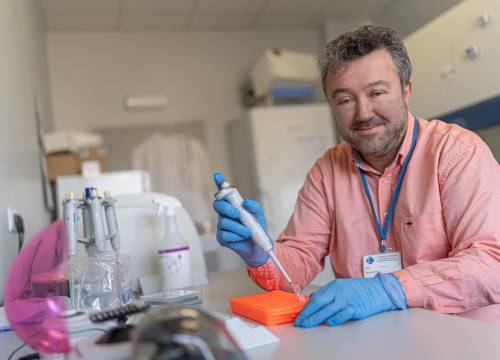Modern diagnostics enable new, targeted therapy for CLL patients

Sometimes examining only one gene can radically change the treatment and prognosis of a patient. A summary of an 18-month study completed by hematologists and geneticists under the direction of Prof. Krzysztof Jamroziak from the Department of Hematology, Transplantation and Internal Diseases of the WMU and Prof. Tomasz Stokłosa from the Department of Cancer Biology and Genetics, was published in one of this year's issues of “Acta Haematologica Polonica”.
The paper, whose first author is Monika Pępek, presents results on the presence of mutations in the TP53 gene in almost 250 patients with chronic lymphocytic leukemia (CLL), the most common cancer of the hematopoietic system in adults. Its pathogenesis consists in the uncontrolled growth of B lymphocytes.
The course of the disease is extremely diverse. Some patients do not require treatment for many years but, unfortunately, in others there is a rapid progression. For the latter, the implementation of the right therapy at the right time is crucial.
Therefore, in the case of CLL, genetic factors come to the fore. The TP53 gene, known as the “guardian of the genome”, is one of the most important anti-cancer genes. The mutant p53, encoded by the TP53 gene, protein not only does not perform the proper function, but may also play an important role in the further transformation of the cancer cell and the progression of the disease, as well as in the development of resistance to therapy. It is in CLL that early detection of mutations in the TP53 gene is extremely important because it places the patient at high risk of leukemia progression.
According to the health care financing policy in Poland, a modern targeted therapy, e.g. with a Bruton kinase inhibitor, may be used in patients with CLL who have mutations in the TP53.
The European Research Initiative on CLL (ERIC) certified the MUW, already in 2016, as the first Polish university, as capable of testing mutations in the TP53 gene with the classic Sanger sequencing technique. In 2019, the MUW was issued another certificate: for the use of the NGS technology for the TP53 testing. Currently, MUW is the only center in Poland with ERIC’s certificates for the testing using the both methods. This is why the PALG association, which brings together over 30 largest hematology centers in Poland, decided to entrust the role of the genetic testing center to the MUW.
Thanks to this program, almost 250 patients had been examined by March 2020 (currently more than 300). The greatest success of this project is the possibility of introducing modern genetic testing not only for patients from Warsaw but also from other 21 Polish cities.
In the study, in which a total of 32 centers took part, 42 patients were found to have mutations in the TP53, thanks to which they could be qualified for targeted therapy. Moreover, 21 of them were found to have subclonal mutations, the discovery of which would be impossible with the classic Sanger technique. Performing so many tests in such a short period of time would not have been possible without the support from the staff and equipment of the Department of Medical Genetics, headed by Prof. Rafał Płoski, and without cooperation with outstanding hematologists from all over Poland.
Editorial commentary to the article wrote Prof. Tadeusz Robak, the world-renowned authority in the field of hematology of CLL research.